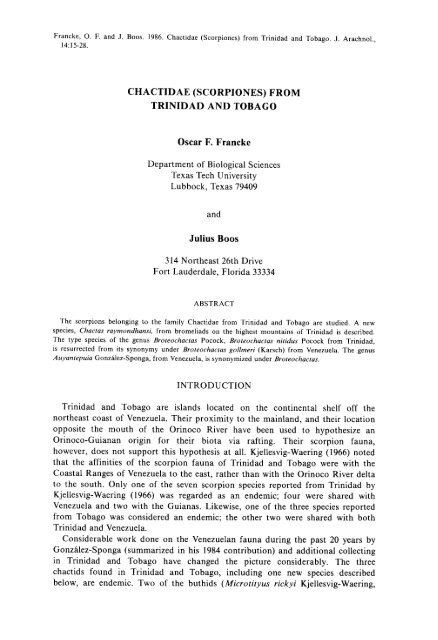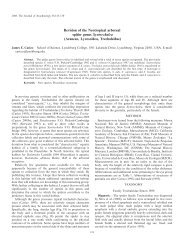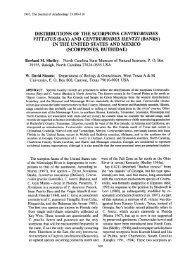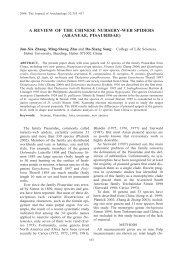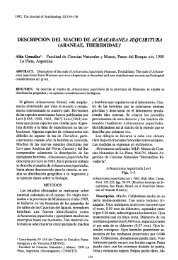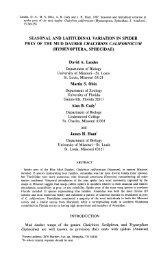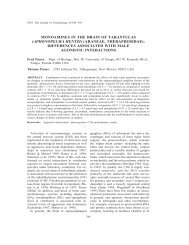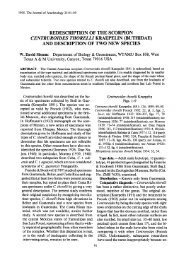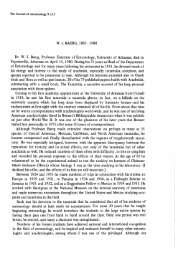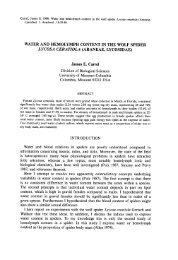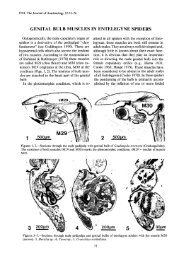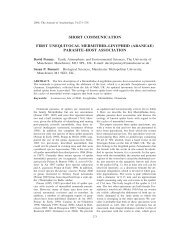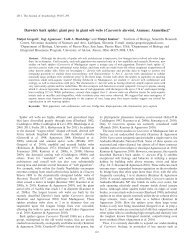CHACTIDAE (SCORPIONES) - American Arachnological Society
CHACTIDAE (SCORPIONES) - American Arachnological Society
CHACTIDAE (SCORPIONES) - American Arachnological Society
Create successful ePaper yourself
Turn your PDF publications into a flip-book with our unique Google optimized e-Paper software.
Francke, O . F. and J . Boos . 1986. Chactidae (Scorpiones) from Trinidad and Tobago . J. Arachnol . ,<br />
14 :15-28 .<br />
<strong>CHACTIDAE</strong> (<strong>SCORPIONES</strong>) FRO M<br />
TRINIDAD AND TOBAG O<br />
Oscar F. Franck e<br />
Department of Biological Science s<br />
Texas Tech Universit y<br />
Lubbock, Texas 7940 9<br />
and<br />
Julius Boo s<br />
314 Northeast 26th Drive<br />
Fort Lauderdale, Florida 3333 4<br />
ABSTRAC T<br />
The scorpions belonging to the family Chactidae from Trinidad and Tobago are studied . A ne w<br />
species, Chactas raymondhansi, from bromeliads on the highest mountains of Trinidad is described .<br />
The type species of the genus Broteochactas Pocock, Broteochactas nitidus Pocock from Trinidad ,<br />
is resurrected from its synonymy under Broteochactas gollmeri (Karsch) from Venezuela. The genus<br />
Auyantepuia Gonzalez-Sponga, from Venezuela, is synonymized under Broteochactas.<br />
INTRODUCTIO N<br />
Trinidad and Tobago are islands located on the continental shelf off th e<br />
northeast coast of Venezuela . Their proximity to the mainland, and their locatio n<br />
opposite the mouth of the Orinoco River have been used to hypothesize a n<br />
Orinoco-Guianan origin for their biota via rafting . Their scorpion fauna ,<br />
however, does not support this hypothesis at all. Kjellesvig-Waering (1966) noted<br />
that the affinities of the scorpion fauna of Trinidad and Tobago were with th e<br />
Coastal Ranges of Venezuela to the east, rather than with the Orinoco River delt a<br />
to the south. Only one of the seven scorpion species reported from Trinidad b y<br />
Kjellesvig-Waering (1966) was regarded as an endemic ; four were shared with<br />
Venezuela and two with the Guianas . Likewise, one of the three species reported<br />
from Tobago was considered an endemic ; the other two were shared with both<br />
Trinidad and Venezuela .<br />
Considerable work done on the Venezuelan fauna during the past 20 years by<br />
Gonzalez-Sponga (summarized in his 1984 contribution) and additional collectin g<br />
in Trinidad and Tobago have changed the picture considerably . The three<br />
chactids found in Trinidad and Tobago, including one new species describe d<br />
below, are endemic. Two of the buthids (Microtityus rickyi Kjellesvig-Waering,
16 THE JOURNAL OF ARACHNOLOG Y<br />
and Tityus trinitatis Pocock) are now also considered endemic to the islands, and<br />
four others are shared with the mainland . The high percentage of scorpio n<br />
endemism (55%) in Trinidad and Tobago reinforces the hypothesis put forth b y<br />
Kjellesvig-Waering (1966) that the Venezuelan Coastal Ranges and the Trinida d<br />
Northern Range were continuous at one time ; subsequently, faulting and erosion<br />
during Pliocene or Pleistocene times led to the isolation of the island fauna. The<br />
lack of shared species between the Orinoco River delta and Trinidad and Tobag o<br />
indicates that rafting is an unlikely dispersal mechanism in scorpions in general .<br />
The terminology used herein follows essentially that of Stahnke (1970), excep t<br />
for trichobothriotaxy (Vachon 1974), and metasomal carinae (Francke 1977) .<br />
Acronyms for specimen depositories are given in the acknowledgments, except fo r<br />
those in the authors' collections which are followed by their initials .<br />
FAMILY <strong>CHACTIDAE</strong><br />
The systematics of this worldwide scorpion family are chaotic and unreliable .<br />
The diagnostic characters given below will readily separate it from the Buthidae ,<br />
the only other family found in Trinidad and Tobago. These characters are also<br />
useful for northeastern South America and the Caribbean region, as the familie s<br />
Bothriuridae, Iuridae and Vaejovidae do not occur there naturally .<br />
Diagnosis .—Sternum pentagonal rather than subtriangular. Tibial spurs absent ,<br />
prolateral and retrolateral pedal spurs present . Cheliceral fingers without ventral<br />
teeth, movable finger with distal ventral tine considerably longer than the dorsa l<br />
tine. Pedipalps with trichobothrial pattern C of Vachon (1974) : femur with thre e<br />
trichobothria, tibia with 5-7 ventral trichobothria. Telson without a ventral toot h<br />
under the sting .<br />
Genus Chactas Gervai s<br />
This genus is known from Central America (Costa Rica and Panama) an d<br />
South America (as far south as Peru and Brazil) . It differs from Broteochacta s<br />
Pocock, the only other genus in this family known from Trinidad and Tobago ,<br />
by having 5-6 instead of 7 ventral trichobothria on the tibia .<br />
Five subgenera are presently recognized within the genus Chactas (Franck e<br />
1985). The new species described below belongs to the subgenus Andinochactas<br />
Gonzalez-Sponga, characterized by having the tarsi armed with a ventral media n<br />
row of spines, and five ventral trichobothria on both the tibia and the chela of<br />
the pedipalps .<br />
Chactas (Andinochactas) raymondhansi, new species<br />
Figs . 1-1 0<br />
Type data .—Holotype male found on a bromeliad along the eastern ridge nea r<br />
the summit of Mt. El Tucuche (1000 m), Northern Range, Trinidad, 26-VI-198 2<br />
(Betty Faber, Eddie Rooks and party) . Deposited in the <strong>American</strong> Museum o f<br />
Natural History, New York . Paratypes listed under specimens examined .<br />
Distribution .—Known only from bromeliads on the highest mountains on the<br />
Northern Range of Trinidad .
FRANCKE AND BOOS—CHACTIDS FROM TRINIDAD AND TOBAGO 1 7<br />
1 2 3 4<br />
0<br />
0<br />
0<br />
0 0<br />
5 7<br />
Figs. 1-7.--Right pedipalp of holotype male of Chactas (Andinochactas) raymondhansi, ne w<br />
species, showing trichobothrial patterns : 1, dorsal aspect of femur ; 2, dorsal aspect of tibia; 3, external<br />
aspect of tibia; 4, ventral aspect of tibia ; 5, dorsal aspect of chela ; 6, external aspect of chela; 7 ,<br />
ventral aspect of chela .<br />
0<br />
0 0
18 THE JOURNAL OF ARACHNOLOG Y<br />
8 9 10<br />
Figs . 8-10 .-Tarsomeres on first right leg of holotype of Chactas (Andinochactas) raymondhansi ,<br />
new species, showing diagnostic curved spiniform seta prolaterally : 8, dorsal aspect ; 9, prolateral<br />
aspect ; 10, ventral aspect .<br />
Etymology . —This species is dedicated to Raymond A. Mendez and Hans E .<br />
A . Boos, joint collectors of the first specimen seen by the junior author . Tha t<br />
specimen started the search that resulted in this publication .<br />
Diagnosis.—Adult males 55-60 mm long, females 60-65 mm . Pedipalp tibi a<br />
(Fig. 4) and chela (Fig. 7) with five ventral trichobothria each . Pectinal tooth<br />
counts 8-11 . Tarsomere I of leg I with a strongly developed, curved spiniform seta<br />
prolaterally (Figs . 8-10). Tarsi on all legs with 5-8 ventral median spines .<br />
Male.—Measurements (lengths in mm) of holotype: carapace 9 .5, metasornal<br />
segment V 8 .8; pedipalp femur 11 .5, tibia 11 .5, chela 20.5. Opisthosorna,<br />
metasoma, chelicera and pedipalps dark red brown ; sternites, legs and telso n<br />
yellow brown. Carapace and tergites acarinate . Pectinal tooth counts 9-11 (mod e<br />
= 9) . Stigmata large, suboval . Sternite VII acarinate. Metasomal segments I-IV :<br />
dorsolateral carinae weak, granulose ; lateral supramedian carinae moderate,<br />
granulose; lateral inframedian carinae on I weak, granulose, on II-IV obsolete ;<br />
ventrolateral keels weak, smooth; ventral submedian keels vestigial, smooth.<br />
Segment V: dorsolateral and lateral median carinae vestigial to obsolete ;<br />
ventrolateral and ventromedian carinae weak, sparsely granulose . Pedipalp s<br />
elongate, femur and tibia longer than carapace, chela slightly over twice as lon g<br />
as carapace. Trichobothrial pattern C (Vachon 1974) : femur orthobothriotaxic
FRANCKE AND BOOS—CHACTIDS FROM TRINIDAD AND TOBAGO 1 9<br />
with 3 trichobothria (Fig. 1); tibia neobothriotaxic with 1 internal, 2 dorsal, 1 7<br />
external, and 5 ventral trichobothria (Figs . 2-4); chela neobothriotaxic with 2 7<br />
trichobothria, 5 ventrals (Figs . 5-7) .<br />
Female .—Measurements (lengths in mm) of largest female : carapace 10 .3 ,<br />
metasomal segment V 8 .8; pedipalp femur 9 .0, tibia 9.0, chela 18 .6. Sternites, leg s<br />
and telson medium brown. Pectinal tooth counts 8-10 (mode = 9) . Pedipalps no t<br />
as elongate as on male : femur and tibia shorter than carapace, chela less than<br />
twice as long as carapace. Curved spiniform seta on tarsomere I of leg I not a s<br />
strongly developed as on male, although still very conspicuous . Other character s<br />
as on male .<br />
Variability.—Male sexual dimorphism in pedipalp length appears with the<br />
penultimate molt ; immature males resemble females morphometrically . Pectinal<br />
tooth counts vary as follows : in males 14 combs with nine teeth, 1 comb wit h<br />
ten teeth, and I comb with eleven teeth ; in females 2 combs with eight teeth, 1 1<br />
combs with nine teeth, and 6 combs with ten teeth . Finally, the diagnostic, curve d<br />
spiniform seta on tarsomere I is present in the smallest specimens examined ( a<br />
male and a female with carapace lengths of 2 .9 and 3.0 mm, respectively ;<br />
probably represent second or third instars) .<br />
Comparisons.—The new species differs from Chactas (Andinochactas) gestro i<br />
Kraepelin, the only other member of the subgenus, (1) by having a strong, curve d<br />
spiniform seta on tarsomere I of leg I, (2) by lacking dense punctations on the<br />
metasoma, and (3) by having higher pectinal tooth counts on both sexes (rang e<br />
8-11 and mode is 9 in C. raymondhansi; range 6-8 and mode is 7 in C . gestroi) .<br />
Remarks .—This species has been collected only from water-filled space s<br />
between leaf sheaths of the bromeliad Glomeropitcairnia erectora Mez. On live<br />
specimens a large chamber extending from the stigmata and surrounding the<br />
book lungs can be seen. This chamber may act as a reservoir for air if<br />
summersion becomes necessary or unavoidable .<br />
The same species of bromeliad occurs on the Paria Peninsula and Margarit a<br />
Island, Venezuela (Smith and Pittendrigh 1967) . A search of this specific habita t<br />
in those locations might reveal the presence of C . raymondhansi, or a clos e<br />
relative, on the mainland .<br />
Specimens examined .—TRINIDAD : Northern Range, on east ridge near summit of Mt El Tucuch e<br />
(1000 m), in bromeliad, 26-VI-1982 (Betty Faber, Eddie Rooks and party), holotype male (AMNH) ;<br />
same locality, in bromeliad 10 feet up small tree, 25-1-1981 (Raymond A. Mendez and Hans Boos) ,<br />
one adult male paratype (JB) ; same locality, in bromeliad, 16-V-1982 (R. W. Bruce, Jr . and L.<br />
Downie), one adult female paratype (JB) ; same locality, in bromeliad, 24-VI-82 (John Murphy an d<br />
Ron Humbert), one adult male paratype (FSCA) ; same locality, in bromeliad, VIII-1982 (M . Read) ,<br />
one subadult female paratype (FSCA) ; same locality, in bromeliad, IX-1982 (M . Read), one subadul t<br />
male paratype (MAGS); same locality, in bromeliad, 1980 (M . Koo), one juvenile male paratyp e<br />
(UWI); El Tucuche (3,000 ft .), 30 October 1937 (E . McC . Callan), one adult male paratype (USNM) ;<br />
Northern Range, top of Mt . Aripo, in bromeliads, 9-X-1982 (M . Read and J . Seyjagat), one adul t<br />
male, one adult female, one subadult female, and one juvenile male paratypes (OFF) ; on ridge 1 mi<br />
W of Mt. Aripo, XI-1982 (M . Read), one juvenile female paratype (JB); El Aripo (2,800 ft .), 2 5<br />
March 1942 (C . G . Pittendrigh), one adult female paratype (USNM); El Aripo (3,085 ft .), 24 Februar y<br />
1944 (A . M . Adamson), one adult female paratype (USNM) ; Northern Range, summit of Morne Bleu ,<br />
in Glomeropitcairnia bromeliad, 4 March 1984 (M . Read), one juvenile female paratype (JB); St.<br />
Augustine, 1941 (E . McC . Callan), one subadult female paratype (USNM) .
20 THE JOURNAL OF ARACHNOLOG Y<br />
Genus Broteochactas Pococ k<br />
Broteochactas Pocock, 1893 . Ann. Mag. Nat . Hist ., set- . 6, 12 :77 (Type species Broteochactas nitidus<br />
Pocock 1893 by original designation) .<br />
Auyantepuia Gonzalez-Sponga, 1978 . Escorpiofauna de la Region Oriental del Estado Bolivar, e n<br />
Venezuela, p. 75. (Type species Broteochactas scorzai Dagert 1957, by monotypy) . NE W<br />
SYNONYMY .<br />
This genus is known from Panama, Colombia, Ecuador, Venezuela, th e<br />
Guianas, Brasil, and Trinidad and Tobago . The type species, originally described<br />
from Trinidad, was synonymized under Broteochactas gollmeri (Karsch) fro m<br />
Caracas, Venezuela, by Kraepelin in 1894, and has remained in synonymy eve r<br />
since. Comparison of material from Caracas, including the lectotype of B.<br />
gollmeri (hereby designated), with specimens from both Trinidad and Tobag o<br />
revealed that these two taxa are not conspecific . Thus, B. nitidus is redescribe d<br />
below .<br />
The genus Auyantepuia was created by Gonzalez-Sponga to accommodat e<br />
Broteochactas scorzai Dagert, from Estado Bolivar, Venezuela. This small specie s<br />
differs from other Broteochactas spp. known from Estado Bolivar in thre e<br />
characters, which is why it was placed in a separate genus . First the dentitio n<br />
in the pedipalp fingers terminates in two distal teeth, rather than three to five .<br />
Second, the trichobothrium designated eb on the external series of the pedipal p<br />
chela finger (Vachon 1974, Gonzalez-Sponga 1978) is found on the finger proper,<br />
rather than on the base of the finger basal to the commissure . Finally, amon g<br />
the supernumerary trichobothria on the external distal series on the tibia, eta i s<br />
"petite" as opposed to ets and ets being "petite ." When all species o f<br />
Broteochactas are considered, rather than only those from Estado Bolivar, B.<br />
scorzai no longer stands out as a generically distinct entity .<br />
The variation in the first character mentioned above appears to be size-related ,<br />
with smaller species having fewer terminal teeth than larger species . Broteochacta s<br />
scorzai and Broteochactas laui Kjellesvig-Waering, the two smallest species in th e<br />
genus, have two terminal teeth on both the fixed and movable fingers of th e<br />
pedipalp chela . Broteochactas nitidus and B. gollmeri, two medium sized specie s<br />
have two terminal teeth on the fixed finger and three on the movable finger.<br />
Finally, some of the larger Broteochactas spp. have three terminal teeth on th e<br />
fixed finger, and three to five on the movable finger . Thus, this character is no t<br />
taxonomically significant at the supraspecific level .<br />
Regarding the second character used to diagnose Auyantepuia, B. nitidus an d<br />
B. gollmeri have trichobothrium eb in the same position as B. scorzai, on the<br />
fixed finger proper, whereas B. laui and some of the larger Venezuelan<br />
Broteochactas spp. have eb on the basal portion near the fingers' commissure .<br />
Thus, this character does not have the taxonomic significance ascribed to it b y<br />
Gonzalez-Sponga .<br />
The third "character" mentioned above actually involves two different ,<br />
subjective problems, each of which is dealt with separately. First, a decision must<br />
be made as to what constitutes a normal versus a "petite" trichobothrium . Among<br />
the six trichobothria assigned to the external terminal (et) tibial series i n<br />
Broteochactas, some species have one with a small pit and short hair, an d<br />
another one with a normal pit but with a short hair (e.g ., B. laui, Fig. 11); some
FRANCKE AND BOOS—CHACTIDS FROM TRINIDAD AND TOBAGO 2 1<br />
1 1<br />
12<br />
Figs . 11-13.—External aspect of pedipalp tibia (drawn on same scale) showing trichobothria l<br />
variability in Broteochactas spp. An open circle denotes a normal trichobothrium, a half-closed circl e<br />
denotes a trichobothrium with a normal pit and a small seta, and a small dot denotes a<br />
trichobothrium with a small pit and a small seta . 11, B. laui, from Tobago ; 12, B. gollmeri, fro m<br />
Venezuela ; 13, Broteochactas sp. from Guyana .<br />
Fig. I4.—Semi-diagrammatic illustration showing that positional variation in one small<br />
trichobothrium can lead to erroneous homologies in designations : a = eta and x = et5, however c =<br />
et 5 and x = eta (see text for further discussion) .<br />
species have two trichobothria with small pits and short hairs (e .g., B. gollmeri,<br />
Fig . 12), and some have two with normal pits but short hairs (e .g ., Broteochacta s<br />
sp ., Fig. 13). The second problem is that created by the numbering conventio n<br />
of Vachon (1974), and used by Gonzalez-Sponga (1978), and its implie d<br />
homologies (see Francke 1982, and Francke and Soleglad 1981, for furthe r<br />
discussion on this problem). In Fig. 14, a small trichobothrium appearing i n<br />
position "a" becomes eta, and "x" becomes et5 ; the same small trichobothrium i n<br />
position "c" becomes et 5 , and "x" is considered as eta : and in position "b" it i s<br />
a toss-up! The reputed difference between Auyantepuia, with trichobothria et a<br />
small and et 5 normal (position "a" in Fig . 14), and Broteochactas, with eta norma l<br />
and et 5 small (positions "b" and "c" in Fig. 14) is based on a false homology an d<br />
certainly does not justify the recognition of two separate genera .<br />
Broteochactas nitidus Pococ k<br />
Figs. 15-20<br />
Broteochactas nitidus Pocock 1893b :339-401, pl . 29, figs . 7-7a .<br />
Broteochactas gollmeri (in part) : Kraepelin 1894 :176-177, 1899 :173, 1912 :53 Pocock 1897 :365-366 ,<br />
1900 :68 ; Mello-Leitao 1932 :32, 1945 :100 .<br />
Broteochactas gollmeri (misidentification) : Roewer 1943 :237 ; Waterman 1950 :169 ; Kjellesvig-Waering<br />
1966 :126 .<br />
13<br />
14
22<br />
17<br />
°<br />
°<br />
1 5<br />
THE JOURNAL OF ARACHNOLOG Y<br />
o<br />
°<br />
i j<br />
18<br />
19 ~—~20<br />
Fig. 15-20.-Right pedipalp of adult male Broteochactas nitidus Pocock, from Trinidad, showing<br />
trichobothrial patterns : 15, dorsal aspect of femur ; 16, dorsal aspect of tibia; 17, external aspect of<br />
tibia; 18, dorsal aspect of chela ; 19, external aspect of chela; 20, ventrointernal aspect of chela .
FRANCKE AND BOOS-CHACTIDS FROM TRINIDAD AND TOBAGO 2 3<br />
Type data.—Lectotype male and seven paralectotypes (hereby designated) fro m<br />
Trinidad (L. E . Broadway). Permanently deposited in the British Museu m<br />
(Natural History) . Examined .<br />
Distribution . Known only from Trinidad and Tobago .<br />
Diagnosis.—Adults 30-35 mm long ; dark brown to black, legs medium to dark<br />
brown. Pectinal tooth count 8 in males, 7 in females . Metasomal segments III-<br />
IV with ventrolateral keels moderate, granulose . Pedipalp chela with three<br />
external trichobothria on finger (Fig . 18) ; dorsal margin of manus with dense ,<br />
coarse granulation; external aspect of manus with fine granules in reticulate d<br />
pattern. Chela length less than twice its width .<br />
Male.—Measurements (lengths in mm) of lectotype male from Trinidad :<br />
carapace 4.1, metasomal segment V 4.7; pedipalp femur 2 .8, tibia 3 .3, chela 6 .3 ,<br />
fixed finger 2 .6. Opisthosoma, metasoma and pedipalps dark red brown ; sternites ,<br />
chelicera and legs light brown ; all areas heavily infuscate . Carapace and tergite s<br />
shagreened, acarinate except for tergite VII with few distal granules o n<br />
submedian and lateral carinal regions . Pectinal tooth count 8 . Stigmata small ,<br />
round . Sternites smooth, acarinate . Metasomal segments I-IV: dorsolatera l<br />
carinae strong, granulose; lateral supramedian carinae moderate, granulose ;<br />
lateral inframedian carinae on I vestigial, subgranose, on II-IV obsolete ;<br />
ventrolateral carinae on I obsolete, on II vestigial and subgranose, on III and IV<br />
weak to moderate and granulose ; ventral submedian carinae on I and II obsolete ,<br />
on III vestigial and subgranose, on IV weak to moderate and granulose . Segmen t<br />
V: dorsolateral and lateromedian carinae weak, finely granulose; ventral keel s<br />
moderate, granulose . Telson with moderately dense, small granulation . Pedipalp s<br />
stout, chela considerably wider (1 .3-1 .5X) than fixed finger length. Bothriotaxi a<br />
C (Vachon 1974): femur orthobothriotaxic with 3 trichobothria (Fig . 15); tibi a<br />
neobothriotaxic with 1 internal, 2 dorsal, 24 external and 7 ventral trichobothri a<br />
(Figs. 16 and 17) ; chela orthobothriotaxic with 26 trichobothria (Figs. 18-20) .<br />
Tarsomere II on all legs armed ventrally with two submedian rows of long setae .<br />
Female.—Measurements (length in mm) of adult from Chancellor Hill ,<br />
Trinidad : carapace 5.0, metasomal segment V 5 .0; pedipalp femur 3 .5, tibia 4 .0 ,<br />
chela 7.6, fixed finger 2 .9 . Pectinal tooth count 7 .<br />
Variability.—The populations from Trinidad and Tobago are remarkabl y<br />
uniform morphologically . However, specimens from mountainous areas tend t o<br />
be darker (almost black) than lowland forms . Pectinal tooth counts display very<br />
low variability: in males 7 combs had seven teeth, 68 combs had eight teeth, an d<br />
1 comb had nine teeth ; in females 2 combs had six teeth, 185 combs had seve n<br />
teeth, and 9 combs had eight teeth .<br />
Comparisons .—Broteochactas nitidus differs from B. gollmeri, with which i t<br />
had been confused, as indicated below . First, in size : carapace length in adul t<br />
males is greater than 4.0 mm in B. nitidus, and less than 4.0 mm in B. gollmeri;<br />
in females greater than 4 .5 mm in B. nitidus, and less than 4 .1 mm in B. gollmeri.<br />
Second, in pectinal tooth counts : in B. nitidus 8 in males, and 7 in females ; in<br />
B. gollmeri 7 in males, and 6 in females . Third, in ornamentation on the dorsa l<br />
and external faces of the pedipalp chela : densely granulose in B. nitidus, smooth<br />
and shiny in B. gollmeri. Fourth, in pedipalp chela proportions : 1 .9 times longe r<br />
than wide in males of B. nitidus, 2.1 times longer than wide in males of B.<br />
gollmeri; 1.8 times longer than wide in females of B. nitidus, 2.15 times longe r<br />
than wide in females of B . gollmeri. Finally, in development of the ventral
24 THE JOURNAL OF ARACHNOLOG Y<br />
submedian carinae on metasomal segments III and IV: weak to moderate an d<br />
granulose on B. nitidus, vestigial and subgranose on B. gollmeri .<br />
Broteochactas nitidus differs from B. laui, with which it coexists on Tobago ,<br />
as follows. First, in size: carapace length in adults of B . laui is less than 4.0 mm .<br />
Second, in pectinal tooth counts : 7 on males and 6 on females of B . laui. Third ,<br />
in the disposition of the external trichobothria along the fixed finger of th e<br />
pedipalp chela: eb basal to the finger commissure in B. laui (Fig. 25), and dista l<br />
to the commissure in B. nitidus (Fig. 19) .<br />
Specimens examined .—TRINIDAD : no date [29 .IV.1890 ?] (L. E. Broadway), lectotype male, tw o<br />
paralectotype males, and five paralectotype females (BMNH) ; 3 .4.1900 (W. Ince), one male, five<br />
females (BMNH) ; Maraval Valley, 1913 (Thaxter), two females (MCZ) ; Port-of-Spain, Jan . 1913 (R .<br />
Thaxter), two juveniles (MCZ); near Salibia, 28 April 1916 (H . L. Clark), one female (MCZ) ; La<br />
Seira Valley, April 1916 (H . L. Clark), two males, two females (MCZ) ; Mt . Tucuche (in bromeliads) ,<br />
28 May 1917 (J. B. Rorer), one female (MCZ) ; Port-of-Spain, 28 Jan. 1926 (W. S . Brooks), one male<br />
(MCZ); Port-of-Spain, February 1942 (H . F. Loomis—A. V. Armour Exp .), two adult female s<br />
(USNM) ; Port-of-Spain, Chancellor Hill (1000 ft .), 20 March 1964 (E . N . Kjellesvig-Waering), three<br />
adult males, one subadult female (FSCA); Simla, 18-25 April 1964 (no collector), four juvenile s<br />
(MCZ) ; Port-of-Spain, 15-V-1965 (E . N . Kj . Waering), two adult, one juvenile females (FSCA) ; Portof-Spain,<br />
Chancellor Hill (1000 ft .), 15-VII-1965 (E . N. Kj . Waering), four males, five female s<br />
(FSCA); Port-of-Spain, 1 May 1966 (E. N. Kj. Waering), one juvenile (FSCA) ; Port-of-Spain ,<br />
Chancellor Hill (1500 ft .), Aug . 1966 (E . N . Kjellesvig-Waering), one adult male, three adult females ,<br />
two subadult females (OFF), three males, one female (FSCA) ; Port-of-Spain, Ft . George Hill (1200<br />
ft.), 15-VIII-1967 (Ricky Kj . Waering), one juvenile male (FSCA) ; Port-of-Spain, Chancellor Hil l<br />
(1500 ft .), March 1968 (E. N . Kj . Waering), four females (FSCA) ; Maraval, N of Port-of-Spain, 1 6<br />
Dec . 1962 (E . N . Kj . Waering), one female (FSCA); Maraval, 4 Mar . 1963 (E . N . Kj . Waering), on e<br />
female (FSCA) ; 5 Mar. 1964 (W. R. Jones), one male, three females (one with 46 first instars )<br />
(FSCA) ; Maraval, 6 March 1964 (W. R . Jones), one female (gave birth in captivity) FSCA) ; Maraval,<br />
13 Mar. 1964 (W . R . Jones), two females (FSCA); Maraval, 12 April 1964 (E . N . Kj . Waering), on e<br />
male, one female (FSCA) ; Maraval, 15 April 1964 (E . N . Kj . Waering), one female (FSCA) ; Maraval,<br />
23 April 1964 (E . N . Kj. Waering), one male (FSCA) ; Maraval, 12-1-1968 (E . N . Kj . Waering), on e<br />
female (with 27 first instars born in captivity) (FSCA) ; Maraval, Fondes Amandes Road, 2 Dec. 196 7<br />
(H . and J . Boos), four females (one with 44 first instars born in the wild) (FSCA) ; Maraval, Fonde s<br />
Amandes Rd ., 24-V-1968 (J . Boos), one female (FSCA) ; Mayaro Beach, 2 mi N Plaisance (2 m), 1 5<br />
Mar . 1964 (E . N . Kj . Waering), one female (FSCA); Mayaro Beach area, Ortoire, 12 June 1964 (E .<br />
N . Kj. Waering), one female (FSCA); Mayaro Beach area, Ortoire Village, 20 Nov . 1964 (E . N . Kj .<br />
Waering), one female (FSCA) ; Mayaro Beach, 15 Nov . 1965 (E. N . Kj. Waering), one male, one<br />
female (FSCA) ; Mayaro Beach, I May 1966 (E . N . Kj. Waering), one female (FSCA) ; Mayaro ,<br />
Ortoire Village, III-1968 (E. N . Kj. Waering), one female (FSCA) ; Mayaro Beach, Ortoire Village ,<br />
15-IV-1968 (E . N . Kj . Waering), three females (FSCA) ; Mayaro Beach, 15-V-68 (E . N . Kj . Waering) ,<br />
one male (FSCA) ; Maracas, 1941 (E . McC . Callan), one adult female (USNM) ; Maracas Valley, 9 -<br />
IV-1968 (Hans Boos), one male, one female (FSCA) ; milepost 6 .4 Maracas Bay to Port-of-Spain Rd .<br />
(800 ft .), l5-VI-1968 (Ricky Waering), one female (FSCA) ; milepost 6-1/4 on Maracas Bay Road ,<br />
20-VIII-1976 (J . Boos), one adult male (JB) ; Mt . Cathrine, 13-1I-1977 (J . Boos), one adult male, one<br />
juvenile female (JB); St. Joseph, Maracas Falls trail, 8-III-1977 (J . Boos), two adult females (OFF) ;<br />
Asa Wright Nature Center, Arima Valley, 16-VII-1978 (R . A. Mendez), one adult female (OFF) ;<br />
Blanchisseuse Valley, 1-11-1979 (R . Mendez and J . Boos), one adult male, one subadult female, one<br />
immature male (OFF) ; El Tucuche (2,000 ft.), June 1944 (A . H . Strickland), one adult female wit h<br />
27 first-instar young (USNM) ; Tucuche (2,500 ft .), 12 November 1944 (A . M . Adamson), one adul t<br />
and one juvenile males (USNM) ; Mt . Tucuche (3000 ft.), I-VI-1969 (Julius Boos), one male (FSCA) ;<br />
trail to Mt . El Tucuche (under rock), 18-11-1979 (J . Boos), one adult male, one subadult female (JB) ;<br />
in leaf litter nr . summit of Mt . El Tucuche, N . Range, 16-V-1982 (R . W. Bruce, Jr. and L . Downie) ,<br />
two adult females (MAGS) ; Verdant Vale Road, off Blanchisseuese Rd ., Arima, July 1982 (M . Read) ,<br />
one adult female (JB) ; Simla, Blanchisseuse Rd ., Arima, Sept. 1982 (M . Read), one adult femal e<br />
(UWI) ; in bromeliad, summit of Mt . Aripo, Northern Range, IX-1982 (M . Read), one female (UWI) ;<br />
Haven Hill farm, Talparo, Nov. 1983 (V. Quesnel), one juvenile female (JB) ; in rotting log, summi t<br />
of Mt. Aripo, Northern Range, 14 Dec. 1983 (M . Read), one adult female (JB) ; Northern Rang e<br />
(2,000 ft .), 8 February 1942 (A. M. Adamson), one adult female (USNM) ; same locality (2,000 ft .),
FRANCKE AND BOOS—CHACTIDS FROM TRINIDAD AND TOBAGO 25<br />
24 March 1943 (A . M. Adamson), one adult male (USNM); Diego Martin, Petit Valley, 5 May 196 4<br />
(E. N . Kj . Waering), one male (FSCA); St. Anns, 12-XI-1968 (J . Boos), two females (FSCA) ; 3 m i<br />
W Morne Bleu, 30-VI-1968 (J . Boos), one female (FSCA) ; l mi W Morne Bleu, 9-11I-1969 (J . Boos) ,<br />
two females (FSCA) . TOBAGO : Speyside, 1 Sept . 1964 (Edgar Lau), one male (FSCA) ; Speyside ,<br />
28 Nov. 1969 (Egbert Lau), one female (FSCA) ; Speyside, .7.1970 (E. N. Kj . Waering), one femal e<br />
(FSCA); road to Hillsborough Dam, May 1977 (Ray Mendez), one adult female (OFF) ; Merticho n<br />
Estate nr. Speyside, 3-IV-1979 (Dave Hardy), one subadult female (JB) ; Pigeon Hill, nr .<br />
Charlotteville, 4-V-1979 (Dave Hardy), one adult female (JB); Pigeon Peak, nr. Charlotteville, 26-27 -<br />
X-1982 (M . Read), two adult females (JB) ; near summit of Pigeon Peak, under stone in gulley, 2 6<br />
Feb . 1984 (M . Read), two adult females (OFF) .<br />
Broteochactas laui Kjellesvig-Waerin g<br />
Figs. 21-2 6<br />
Broteochactas laui Kjellesvig-Waering 1966 :126-128, figs . 1-2 ; Gonzalez-Sponga I974a :5, I974b:300 .<br />
Type data.—Holotype female from Speyside (Paradise Inn Hotel), Tobago .<br />
Permanently deposited in the <strong>American</strong> Museum of Natural History, New York .<br />
Not examined .<br />
Distribution .—Known only from Tobago .<br />
Diagnosis.—Adults 22-25 mm long; medium brown and heavily infuscate, with<br />
legs yellow brown and lightly infuscate . Pectinal tooth counts 6-7 (mode = 7) i n<br />
males, 5-7 (mode = 6) in females . Pedipalp chela with two external trichobothri a<br />
on finger (Fig. 25); dorsal and external aspects of chela densely and coarsel y<br />
granulose . Carinae on metasomal segments I-IV absent, except for lateral<br />
supramedians on I and II and dorsolaterals on III and IV which are weak an d<br />
subgranose .<br />
Female.—Measurements (length in mm) of adult paratype from Speyside ,<br />
Tobago: carapace 3 .7; metasomal segment V 3 .1; pedipalp femur 2.1, tibia 2 .6 ,<br />
chela 5 .0, fixed finger 1 .9. Opisthosoma and metasoma medium brown, heavil y<br />
infuscate; pedipalps dark red brown, heavily infuscate ; sternites, chelicera and leg s<br />
yellow brown, lightly infuscate . Carapace and tergites acarinate, smooth and<br />
shiny. Sternites smooth and shiny; stigmata small, round . Metasomal carinae o n<br />
I-IV: lateral supramedians on I and II, and dorsolaterals on III and IV weak ,<br />
subgranose ; all others obsolete. Segment V with dorsolateral keels weak, finel y<br />
granulose; ventral keels moderate, granulose . Telson shiny, with sparse smal l<br />
granules. Pedipalps stout ; chela with broad, stubby fixed finger. Bothriotaxia C<br />
(Vachon 1974) : femur orthobothriotaxic with 3 trichobothria (Fig . 21); tibia<br />
neobothriotaxic with I internal, 2 dorsal, 24 external, and 7 ventral trichobothri a<br />
(Figs. 22 and 23) ; chela orthobothriotaxic with 26 trichobothria (Figs . 24-26) .<br />
Tarsomere II on all legs armed ventrally with two submedian rows of setae .<br />
Male.—Measurements (lengths in millimeters) of adult paratype from Speyside ,<br />
Tobago: carapace 3 .5; metasomal segment V 3 .5 ; pedipalp femur 2 .2, tibia 2 .7 ,<br />
chela 4.7, fixed finger 1 .7. Differ from females primarily in pedipalp chel a<br />
proportions, having a wider manus and a shorter fixed finger ; in pectina l<br />
morphology, with one more tooth, and each tooth is 2 .5 to 3 times longer tha n<br />
on females .<br />
Variability . —Pectinal tooth counts varied as follows : on males 1 comb with si x<br />
teeth, 3 combs with seven teeth (one male reported upon by Kjellesvig-Waerin g<br />
1966); on females 1 comb with five teeth, 22 combs with six teeth, and 7 comb s<br />
with seven teeth .
26 THE JOURNAL OF ARACHNOLOGY<br />
23<br />
25<br />
22<br />
Figs . 21-26.-Right pedipalp of adult female Broteochactas laui Kjellesvig-Waering, from Tobago ,<br />
showing trichobothrial patterns: 21, dorsal aspect of femur; 22, dorsal aspect of tibia ; 23, external<br />
aspect of tibia ; 24, dorsal aspect of chela ; 25, external aspect of chela; 26, ventrointernal aspect o f<br />
chela.
FRANCKE AND BOOS—CHACTIDS FROM TRINIDAD AND TOBAGO 27<br />
Comparisons.—See the section under B. nitidus for differential characters wit h<br />
that species .<br />
Specimens examined .—TOBAGO : Speyside (under rocks in burrows ; forest), 15-11-1965 (Edgar<br />
Lau), one adult male, one adult female paratypes (FSCA) ; Speyside, 20 April 1965 (Edgar Lau), tw o<br />
adult female paratypes (FSCA) ; between Charlotteville and Speyside, 29 Oct. 1982 (M . Read), on e<br />
adult female (JB) ; milepost 26 Windward road, among rocks and soil from walls of gulley in cocoa<br />
plantation, 19-20 Feb . 1984 (M . Read), five adult, one subadult and three juvenile females (JB, OFF) .<br />
ACKNOWLEDGMENT S<br />
We thank Dr. Mary Alkins, Department of Zoology, University of the Wes t<br />
Indies, St. Augustine, Trinidad (UWI), Dr . J. Coddington, U. S . National<br />
Museum, Washington, D . C. (USNM), Dr. G. B . Edwards, Florida State<br />
Collection of Arthropods, Gainesville, Florida (FSCA), Mr. P. D. Hillyard ,<br />
British Museum (Natural History), London (BMNH), Dr. H . W. Levi, Museu m<br />
of Comparative Zoology, Harvard University, Cambridge (MCZ), and Dr . M .<br />
Moritz, Zoologisches Museum der Humboldt Universitat, Berlin (ZMB) for th e<br />
loan of specimens. Dr. M. A . Gonzalez-Sponga (MAGS) kindly donated som e<br />
Venezuelan scorpions to the senior author, and gave advice and loaned specimen s<br />
to the junior author . Special thanks to the many collectors of specimens who ar e<br />
mentioned in the text, in particular Dr. Morley Read and Mr. John Seyjagat ;<br />
and to Mr. J. Santiago-Blay for locating specimens in the collection of the U .<br />
S . National Museum . Finally, Dr. W. D . Sissom and Mr. S. A. Stockwell kindly<br />
commented on a draft of the manuscript .<br />
LITERATURE CITE D<br />
Francke, O . F. 1977. Scorpions of the genus Diplocentrus from Oaxaca, Mexico . J. Arachnol ., 4 :145 -<br />
200 .<br />
Francke, O . F. 1982. Studies of the scorpion subfamilies Superstitioninae and Typhlochactinae, wit h<br />
description of a new genus (Scorpiones, Chactoidea) . Bull . Assn . Mexican Cave Studies, 8 :51-62 .<br />
Francke, O . F. 1985 . Conspectus Genericus Scorpionorum (Arachnida, Scorpiones) . Occas. Papers<br />
Mus ., Texas Tech Univ ., No. 98, 32 pp .<br />
Francke, O. F. and M. E. Soleglad . 1981. The family Iuridae Thorell (Arachnida, Scorpiones). J .<br />
Arachnol ., 9 :233-258 .<br />
Gonzalez-Sponga, M . A. 1974a. Broteochactas sanmartini: nueva especie del Rio Caura, en l a<br />
Guayana de Venezuela . Monografias Cientificas "Augusto Pi Sutler", Caracas, No . 7, 16 pp .<br />
Gonzalez-Sponga, M. A. 1974b . Una nueva especie de escorpiones de la Amazonia Venezolan a<br />
(Chactidae) . Acta Biol . Venezuela, 8 :299-313 .<br />
Gonzalez-Sponga, M . A . 1978. Escorpiofauna de la region oriental del Estado Bolivar, en Venezuela .<br />
Consejo Nac . Inv . Cient . Tecnol. Caracas, Roto-Impresos C . A ., 217 pp .<br />
Gonzalez-Sponga, M . A . 1984 . Escorpiones de Venezuela . Cuadernos Lagoven, Cromotip, Caracas ,<br />
126 pp .<br />
Kjellesvig-Waering, E . N. 1966 The scorpions of Trinidad and Tobago . Caribbean J . Sci ., 6 :123-135 .<br />
Kraepelin, K . 1894 . Revision der Skorpione. II: Scorpionidae and Bothriuridae . Jahrb. Hamburg .<br />
wiss . Anst ., 11 :1-248 .<br />
Kraepelin, K . 1899 . Skorpiones and Pedipalpi . Das Tierreichs, 8:1-265 .<br />
Kraepelin, K. 1912. Neue Beitrage zur Systematics der Gliederspinnen . II. Chactinae. Jahrb .<br />
Hamburg . wiss . Anst ., 29 :45-88 .<br />
Mello-Leitao, C . de 1932 . Notas sobre escorpioes Sul-<strong>American</strong>os . Arq . Mus . Nac. Rio de Janeiro ,<br />
34 :9-46 .<br />
Mello-Leitao, C. de 1945 . Escorpioes Sul-<strong>American</strong>os . Arq . Mus. Nac. Rio de Janeiro, 40 :7-468 .<br />
Pocock, R . I. 1893a. A contribution to the study of Neotropical scorpions . Ann. Mag. Nat. Hist . ,<br />
ser . VI, 12:77-103 .
28 THE JOURNAL OF ARACHNOLOG Y<br />
Pocock, R . I . 1893b. Contributions to our knowledge of the arthropod fauna of the West Indies . —<br />
Part I. Scorpiones and Pedipalpi ; with a supplementary note upon the freshwater Decapoda o f<br />
St . Vincent . J . Zool . Linn . Soc., London, 24 :374-409 .<br />
Pocock, R . I . 1897. Report upon the Scorpiones and Pedipalpi obtained on the Lower Amazon b y<br />
Messrs. E. E. Austen and F. Pickard-Cambridge during the trip of Mr. Siemen's Steamship<br />
"Faraday ." Ann. Mag . Nat . Hist ., ser . VI, 19 :357-368 .<br />
Pocock, R. I . 1900 . Myriapoda and Arachnida, in Report on a collection made by Messrs. F. V.<br />
McConnell and J. J. Quelch at Mr . Roraima in British Guiana . Trans. Linn. Soc. London, ser .<br />
II, 8 :64-71 .<br />
Roewer, C. F. 1943. Ueber eine neuerworbene Sammlung von Skorpionen des Natur-Museum s<br />
Senkenberg . Senckenbergiana, 26 :205-244 .<br />
Smith, L. B. and C . S. Pittendrigh. 1967 . Bromeliaceae. Pp . 37-50, In Flora of Trinidad and Tobago .<br />
Ministry of Agriculture, Industry and Commerce, Trinidad and Tobago . Government Printery ,<br />
Trinidad .<br />
Stahnke, H . L . 1970 . Scorpion nomenclature and mensuration . Entomol . News 81 :297-316 .<br />
Waterman, J. A. 1950. Scorpions in the West Indies with special reference to Tityus trinitatis .<br />
Caribbean Med . J ., 12 :167-177 .<br />
Vachon, M . 1974. Etude des caracteres utilises pour classer les families et les genres de Scorpion s<br />
(Arachnides) . Bull . Mus. Nat. Hist. Nat. Paris (ser . Zool .), 104 (140) :859-958 .<br />
Manuscript received August 1985, revised October 1985 .


